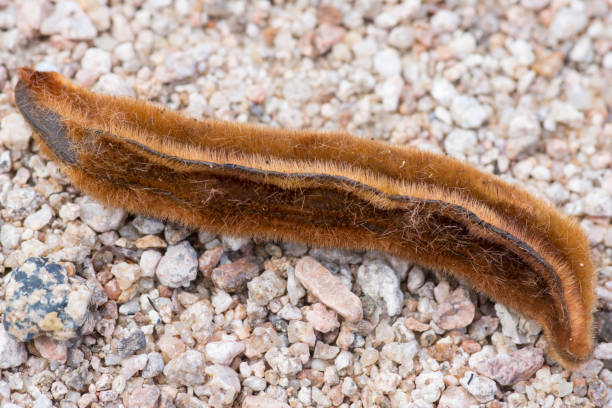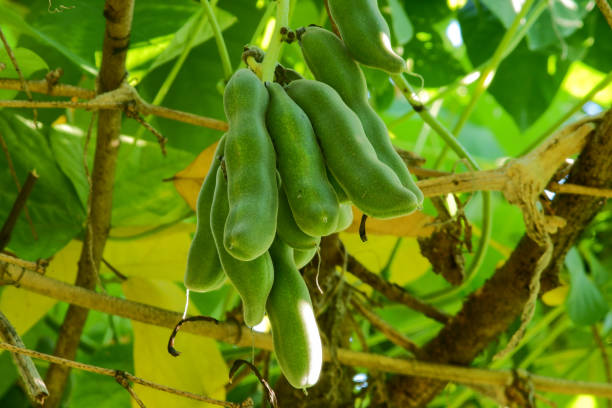

Mucuna pruriens (L.) DC.
|
It is commonly known as Kivanch and belongs to the Fabaceae family.Tender pods after repeated boiling are cooked and consumed as vegetable. Bioactive compounds 2-Myristynoyl-glycinamide and 9, 12-Octadecadienoic acid/linoleic acid were reported from M. pruriens. The seed extract significantly inhibited release of nitric oxide (NO), IL-1β, IL-6, and TNF-α in LPS-stimulated BV2 microglial cells and also inhibited the translocation of NF-κB. Mode of Consumption : Cooked after repeated boiling |
| Plant Details | Agro-climatic Zone | Vernacular Names | Pictures |
| Scientific Name: Mucuna pruriens (L.) DC. Family: Fabaceae Lindl. Class: Magnoliopsida Order: Fabales Genus: Mucuna Adans Fruiting Season: December to February Parts: Pod |
|
Andhra Pradesh : Pilliadugu, Kanduspala, Dulagondi, Punaikkali, Poonaikaali, Pilliadugu, Kapikacchuh Assam : Bandor-kekua, Akolchi, Alakusi, Alkushi, Bichchoti Bihar : Kevanch, Konch, Kiwach, Kivanch, Jara, Jangali, Kiwach, Daunch, Goncha Delhi : Kevanch, Konch, Kiwach, Kivanch, Jara, Jangali, Kiwach, Daunch, Goncha Gujarat : Kivanch, Kavatch Haryana : Kevanch, Konch, Kiwach, Kivanch, Jara, Jangali, Kiwach, Daunch, Goncha Jammu & Kashmir : Jara, Jangali Jharkhand : Kevanch, Konch, Kiwach, Kivanch, Jara, Jangali, Kiwach, Daunch, Goncha Karnataka : Nasugunni, Nasukunni, Nosagonne, Nayisonanguballi Kerala : Naicorna, Naikkuran, Naicorna Madhya pradesh : Kevanch, Konch, Kiwach, Kivanch, Jara, Jangali, Kiwach, Daunch, Goncha Maharashtra : Khaj-kuiri, Kavachkuiri, Kavachkuili, Kavaskuiri, Kavaskuili, Khazrikuiri, Khazrikuili, Kavacha, Kuhili, Kanchkuri Odisha : Kaincho Rajasthan : Kevanch, Konch, Kiwach, Kivanch, Jara, Jangali, Kiwach, Daunch, Goncha Tamil Nadu : Punaippidukkan Telangana : Pilliadugu, Kanduspala, Dulagondi, Punaikkali, Poonaikaali, Pilliadugu, Kapikacchuh, Jara Tripura : Akolchi, Alakusi, Alkushi, Bichchoti Uttar pradesh : Kevanch, Konch, Kiwach, Kivanch, Jara, Jangali, Kiwach, Daunch, Goncha Uttarakhand : Kevanch, Konch, Kiwach, Kivanch, Jara, Jangali, Kiwach, Daunch, Goncha West Bengal : Akolchi, Alakusi, Alkushi, Bichchoti, Jara, Jangali |
 Dry pod  Plant with pods |
| Compound/Extract | Activity | Mode of Action | Marker/References |
| Methanolic seed extract | Anti-inflammatory | Methanolic seed extract (250 & 500 mg/kg) inhibited delayed hypersensitivity reaction (DTR) in mice. It elevated secondary sheep red blood cells (SRBCs) specific antibody titre with antibody response. It inceased leucocyte mobilization. | [1] |
| Peptide fractions | Anti-inflammatory | Peptide fractions (F5–10 kDa at 300 μg/mL) inhibited NO and H2O2 production and reduced the IL-6 and TNF-α levels in BALB/c mouse macrophages. | NO, H2O2, IL-6, and TNF-α[2] |
| Seed extract | Anti-inflammatory | Seed extract significantly inhibited the release of inflammatory mediators including nitric oxide (NO), IL-1β, IL-6, and TNF-α in LPS-stimulated BV2 microglial cells and inhibited the translocation of NF-κB. | NO, IL-1β, IL-6, TNF-α, and NF-κB[3] |
| Seed derived serum immunoglobulins | Antivenom | In vitro-in vivo neutralization assay showed M. pruriens derived serum immunoglobulins effectively inactivates Cobra venom in mice. | [4] |
| Major Class | Metabolites (Content of bioactives: mg/100g Fresh Weight) |
| Fatty acid | 9,12-Octadecadienoic acid/linoleic acid: , Dodecanoic acid/lauric acid: [5] |
| Fatty acid ester | Pentadecanoic acid, 14- methyl-methyl ester: [5] |
| Polyenoic fatty acid | 9,12-Octadecadienoic acid (Z,Z)-, methyl ester: [5] |
| Effect | Observation | DOI |
| Disease | Formulation | Reference | Author | TKDL |
| Cough / Bronchitis, Dyspnoea, Plenosthotonus, Diseases of heart, Haemorrhagic diseases | Dadimadi Ghritam | Bharata Bhaishajya Ratnakara - Vol.-III | compiled by Naginadasa Chaganalala Shah, Translated by Gopinath Gupta | Ayurveda |
| Diseases of the urinary system, Seminal disorders | Jeevanayanam | Bharata Bhaishajya Ratnakara - Vol.-II | compiled by Naginadasa Chaganalala Shah, Translated by Gopinath Gupta | Ayurveda |
| Dyspnoea | Marktibeejayoga | Bharata Bhaishajya Ratnakara - Vol.-IV | compiled by Naginadasa Chaganalala Shah, Translated by Gopinath Gupta | Ayurveda |
| Paralysis/Hemiplegia | Mash tailam 1 | Bharata Bhaishajya Ratnakara - Vol.-IV | compiled by Naginadasa Chaganalala Shah, Translated by Gopinath Gupta | Ayurveda |
| Paralysis/Hemiplegia, Facial Paralysis, Earache / Otalgia, Deafness, Sannipataja / Tridosaja, Cataract, Paralysis agitans / Tremors, Brachial neuralgia, Frozen shoulder, Lathyrism, Diseases of head and neck | Mash tailam 2 | Bharata Bhaishajya Ratnakara - Vol.-IV | compiled by Naginadasa Chaganalala Shah, Translated by Gopinath Gupta | Ayurveda |
| Aphrodisiac | Mushalyadi churnam | Bharata Bhaishajya Ratnakara - Vol.-IV | compiled by Naginadasa Chaganalala Shah, Translated by Gopinath Gupta | Ayurveda |
| Information from Wealth of India | Reference |
|
CSIR(1962).The Wealth of India, Raw materials,Vol.-VI ,P.442-443, New Delhi, India |
| 4.2, 04.2.1, 04.2.1.1, 04.2.1.2, 04.2.1.3, 04.2.2.6, 04.2.2.8 |
| CSIR-North East Institute of Science and Technology, Jorhat-6, Assam, India
CSIR-Institute of Himalayan Bioresource Technology, Palampur-61,Himachal Pradesh, India |